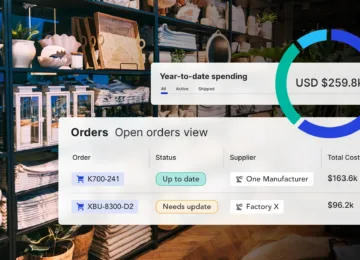Growing your business often relies on optimizing the systems you have in place rather than looking elsewhere for opportunities. Your supply chain is an important part of your organization’s functionality, and because it is so complex, there are many ways to improve it.
However, improving your supply chain requires knowing what areas need improvement or aren’t currently functioning at an optimal level. Conducting a supply chain audit can help you discover more about the health of your supply chain and identify areas of focus for continuous improvement and growth. In this article, we’ll go over the steps of an audit and explain how supply chain management software can help.
What is a Supply Chain Audit?
A supply chain audit is a detailed examination and critique of your supply chain process. It checks in on each of the suppliers that you rely on and makes sure that costs are controlled and risk factors are mitigated to keep your supply chain running as smoothly as possible. An audit can tell if any disruptions have harmed your performance or damaged the procurement of goods.
There are many benefits of running a supply chain audit, including:
- Creating better and stronger business relationships with suppliers
- Finding room for improvement in health & safety, environmental sustainability, anti-corruption, working conditions, finance, and other areas of concern
- Identifying opportunities to update and improve service agreements
- Increasing your supplier’s compliance with essential standards of operation
- Building more reliability, trust, and credibility
- Improving the performance of your supply chain
- Identifying and resolving fraud or system errors
- Finding risks in your supply chain that could damage revenue and your brand’s reputation
How Do You Prepare to Conduct a Supply Chain Audit?
Before you can even begin your audit, a few planning steps need to happen first. An audit is a massive overhaul, and if you don’t have your steps in place before you begin, your audit team can be disorganized and ultimately unsuccessful. By planning your audit correctly, you can enjoy the benefits and ensure that you aim toward success.
Planning and strategic steps you’ll want to outline before you begin your audit include:
- Plan your audit: Have a strict plan that you want to follow before beginning the audit. This ensures that all auditors have the same guidelines and rules before starting.
- Standardize criteria: The information gathered during the audit must be examined and evaluated thoroughly. All auditors should have standardized criteria to compare findings against to avoid confusion and keep data organized.
- Decide how to communicate results: Another step to plan before the audit is how you’ll communicate the results back to the company. There should be a clear and precise way of reporting that gives stakeholders actionable insights and informs them of decisions they need to make.
- Determine how to follow up: You’ll also want a plan for the actions following an audit. A clear plan helps ensure that all findings in the audit are corrected, and appropriate measures have been taken.
Implement Supply Chain Management Software
In addition to the steps listed above, you’ll also want to make sure you have the right tools at your disposal to conduct your audit. Without the right software, your audit might have to be done manually in parts, leading to errors, slowdowns, bottlenecks, and even incomplete audits.
Audits are much easier and more manageable with the support of supply chain management (SCM) or supply chain risk management (SCRM) software like Anvyl. These platforms help manufacturing organizations:
- Track, review, and expedite transactions with digital documentation.
- Maintain a secure record of supply chain data that integrates with an ERP or other records system.
- Monitor the movement of products through the supply chain.
- Convert data into easily readable reports and findings.
How to Audit Your Supply Chain
Conducting an internal audit is an integral part of examining your supply chain and evaluating the health of your organization. An audit helps ensure that everything is running as it should and that all parties are following the same set of rules. It is designed to add value to an organization and back up data with clear processes.
An internal audit helps determine if any problems need to be remedied within your systems. You can then look at introducing solutions that can ease those challenges, like new software, systems, processes, or procedures that help manage supply chain relationships and keep everything running smoothly.
If you plan to conduct an audit but are unsure how to start, we’ll walk through the steps of a supply chain audit in more detail below.
Assess and Manage Risks
There are different types of risks in the supply chain that all manufacturers face, regardless of industry. Manufacturers must assess and manage these risks to maintain an effective supply chain.
Reputation
Your reputation depends on how consumers look at your practices and deem them as acceptable or questionable. If, for example, a portion of your consumers believe your practices to be unethical, you risk damaging your reputation. Keeping things above board and being transparent in your practices helps mitigate reputational damage.
Pricing
Pricing refers to the market prices of your goods. They can change when the price of materials changes or your expenses rise. This can affect the flow of your supply chain if, for example, your raw material costs rise and your product becomes more expensive and less desirable to consumers. Making sure you are getting the best deal can help mitigate pricing risks.
Cybersecurity
Cybersecurity is essential, as it’s an emerging risk for manufacturers. As software attacks on the supply chain become more frequent, you need to review your cybersecurity processes and create systems that protect your valuable data. This can help you avoid undue cybersecurity risks.
Geopolitics
The global supply chain relies on compliance between different regions and geopolitical areas. However, when there are global conflicts like the war in Ukraine, it can affect the tariffs and trade agreements between nations. Having alternate suppliers in different regions can help you avoid geopolitical risks.
Inventory Management
Another area of risk is inventory management. When a business doesn’t transport or store inventory correctly, it can lead to inventory waste and shortages of the materials needed to complete orders. Having an undamaged stock and inventory is key to success. Inventory management systems can help you track and maintain inventory.
Contract Management
The contracts that you have with suppliers can also affect your supply chain. For example, if one department owns contracts but does not oversee performance, it can lead to unintentional contract breaches. Keeping people trained and in compliance with agreements can mitigate contract management risks.
Quality
The quality of goods received also plays a part in your supply chain. Damaged goods or poor-quality materials can derail your business processes. Having quality assurance procedures in place can help keep you and your supplier at a high standard and avoid any quality control issues.
Shipping
Shipping is essential to manufacturing and production, as it is how materials and goods are transported to buyers. However, things like weather conditions and the running condition of trucks and ships can delay the supply chain. Creating new delivery procedures can help you avoid any undue risks from supply chain shipping.
Legal
Your business can suffer if your suppliers engage in illegal activity, even if you are unaware of it. Improving your contracts and creating rules and regulations for suppliers to follow keeps you compliant and avoids legal risks.
Review and Cross Reference Transactional Data
The next step of an audit is to review and cross-reference your transactional data. This helps ensure that there are no errors or discrepancies across your documents and data. It also ensures that there are no conflicts with the quality, number, or price of goods.
Information that your audit should cross-reference includes:
- Receipts and purchase orders
- Receipts and shipping notices
- Receipts and QA reports
- Invoices and QA reports
- Shipping notices and purchase orders
Examine Your Data Log
The final step in your internal audit is to examine your data log. The data log keeps track of all of the information that your team members log. Your auditors need to know who changes data, how data is altered, and where in your organization these changes happen.
Team members might change data for innocuous reasons like correcting an error. However, suppliers can also make fraudulent changes, including raising the price of an item to create a false purchase order, then sending that order to you, and lowering the price again so that you are unaware of the changes.
The Risk-Based Supply Chain Audit Process
While running an internal audit is vital for your supply chain’s success, you should also conduct external audits aimed at your suppliers. External audits, also known as supplier audits, can help you reduce risk among your suppliers. It also gives you big-picture insights into which tactics are successful for your supply chain, and which suppliers need to improve to meet your standards. Let’s take a closer look at each step of the risk-based supply chain audit process.
Supplier Self-Assessment
You can begin external audit programs by having the supplier examine themselves for areas of weakness or improvement. The assessment report the supplier fills out will take place before any onsite evaluation, and is meant to give you an idea of what to expect during the full audit.
Onsite Audit
The onsite audit is the entire, complete audit at the supplier facility. The onsite audit helps to provide an accurate picture of the practices, procedures, plans, and processes that the supplier manages.
Opening & Closing Meetings
An external supplier audit will have meetings at the beginning and end of the process. This sets clear expectations and avoids confusion between your organization and the supplier about timeframes, verification standards, and acceptance.
Verify Risk Mitigation Procedures
Once the audit is complete, you can begin to put procedures in place to follow that will track the risk mitigation in place and ensure that the supplier addresses the issues found in the audit.
Annual Re-Verification
The audit shouldn’t be a one-and-done deal. The audit should be re-verified annually to ensure that the supplier meets compliance goals and takes corrective action. In addition to checking for noncompliance, re-verification can also help you stay ahead of (and address) any potential issues between you and the supplier.
Review KPIs
Your suppliers should have some key KPIs and metrics for you to review. These KPIs will help you determine whether or not the supplier is meeting the audit requirements or if they have failed the audit. Consider asking your supplier for the following metrics:
- Product presentation
- Correct labeling
- Pallet configuration
- Transaction timing
- Timelines and accuracy of advance shipping notices
- Timeliness of invoicing
- Rate of accepting purchase orders
- Product quality
- Accuracy of invoices
- Accuracy of fulfillment
Streamline Supply Chain Audits With Anvyl
A supply chain audit is essential for improving your entire manufacturing organization. Without regular audits, you won’t be able to tell when areas in your supply chain need support or when your business operations aren’t functioning optimally. Having an audit process in place will ensure that you can identify areas of improvement and create better systems.
Supply chain management software like Anvyl can make a supply chain audit much easier to conduct. With the help of our tools, you can easily streamline your audit process and get accurate, real-time data from a single source of truth. Get a demo of Anvyl today to see what our platform can do for you and your organization.



